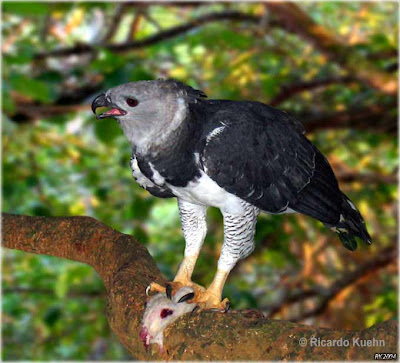




Harpy Eagle (Harpia harpyja) Classification: Class Aves (birds), Order Falconiformes, Family Accipitridae, Genus Harpia, Species harpyja
IUCN Status: Near-Threatened
The near-threatened Harpy Eagle is one of the world's largest birds. These raptors (or birds of prey) are only found in the Central and South American rainforests. They are one of the 600 species of birds that inhabit Yasuni National Park.
Harpy Eagles are powerful raptors; they are able to pluck monkeys right out of tree tops. Besides primates, this voracious carnivore feeds on other birds, sloths, opossums, large reptiles, and large rodents. Their hunting skills can be attributed in part to their impressive anatomy. Harpies have talons as long as grizzly bear claws (5 inches) and their wingspan is near in length to the height of an NBA basketball player (6-and-a-half feet). They can fly at speeds above 50 mph. Females weigh 14-18 lbs. and are larger than their male counterparts, which weigh 10-14 lbs. Harpies' bodies are almost 3 feet long.
Harpy pairs mate for life and establish nests in high trees or cliffs (above 130 ft). Females lay 1-2 eggs that have an incubation period of 53-56 days. Usually only one offspring survives, and both sexes care for the young.
Harpy Eagles are in danger of becoming extinct due to habitat fragmentation, habitat destruction, and hunting. The proposed oil road into Yasuní National Park will fragment their habitat and could have a dire effect on the Harpy Eagles' already tenuous population.





